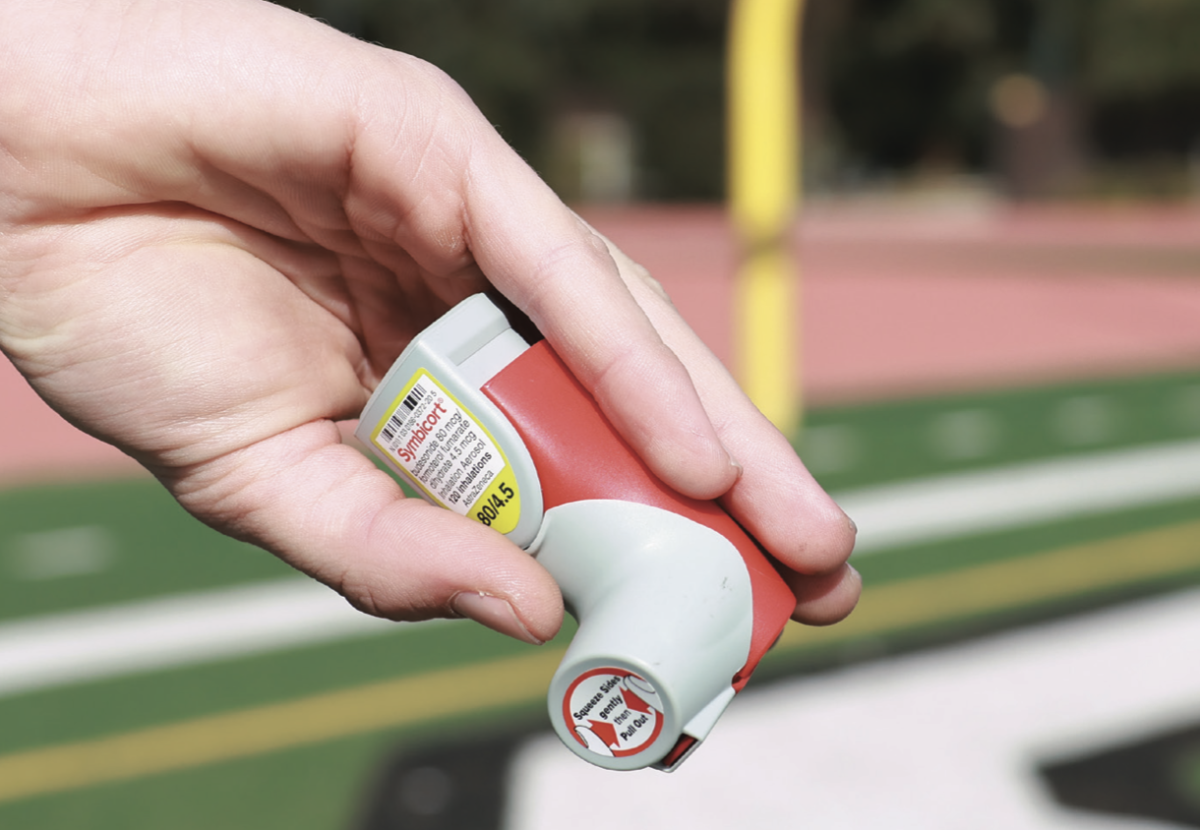In recent years, childhood asthma has become a significant concern for Palo Alto parents, healthcare professionals, and worldwide policymakers alike.
According to the World Health Organization, an estimated 339 million people suffer from asthma globally, with a considerable portion being children. This chronic respiratory condition not only affects a child’s physical health but also impacts their overall quality of life. To address this growing issue, it is crucial for parents to understand the causes, symptoms, and management of childhood asthma.
Here, at Palo Alto High School, many student-athletes suffer from a type of asthma called Exercise-Induced Bronchoconstriction (EIB) which describes a reversible contraction of bronchial smooth muscle after physical exertion. A study conducted by the National Library of Medicine concluded that “at least 15% to 25% of athletes may have signs and symptoms suggestive of asthma, including exercise-induced asthma.”
Symptoms of asthma can lessen after puberty, but can reappear in any time of life, making it an unpredictable and incurable condition. Parents need to be vigilant about recognizing the symptoms of asthma in their children. Persistent coughing and wheezing sounds during exhalation are common signs of asthma.
One of Paly’s athletes, Rohit Sengupta (‘25), participates in mountain biking. Sengupta has had some drawbacks due to his mild asthma, including surviving five severe asthma attacks.
“Asthma affects me by decreasing the intake of oxygen into my lungs which makes hardcore situations feel like drowning or being choked by the neck,” Sengupta said. “It also affects my mood by decreasing the oxygen in my blood.”
Asthma affects me by decreasing the intake of oxygen into my lungs which makes hardcore situations feel like drowning or being choked by the neck”
— Rohit Sangupta ('25)
Sengupta’s lifelong battle with asthma has imbued his racing journey with unique challenges. Since his diagnosis at birth, he has created his own set of strategic measures to mitigate the effects of his condition on his athletic performance, which have been super helpful in many ways.
One strategy that has been helpful involves meticulous monitoring of his heart rate during competitions, ensuring that he does not strain his lungs beyond their capacity. This vigilance not only safeguards his physical well-being but also optimizes his ability to perform his best in races to take the win.
In addition to monitoring his heart rate, Sengupta maintains open and transparent communication with his coaches about the health implications of his asthma. His close relationships with his mentors fosters an environment where both parties are acutely aware of the challenges he faces. Such clear lines of communication prove invaluable, especially during moments of panic, offering reassurance and guidance to Sengupta as he navigates the complexities of competitive racing.
Through his resilience, strategic approach, and effective communication with his support team, Sengupta not only overcomes the hurdles imposed by asthma but also emerges as a beacon of inspiration, demonstrating the power of determination and collaboration in the face of adversity.
Sengupta proves to everyone that while asthma is a chronic condition, it can be effectively managed with proper medical guidance. Pediatricians often prescribe inhalers and medication to control inflammation and open the airways. Asthma can actually be triggered by surrounding environmental factors.
Identifying and avoiding these triggers is fundamental in managing childhood asthma. Common triggers include tobacco smoke, allergens like pollen and pet dander, air pollution, strong odors, and respiratory infections. Creating an asthma-friendly environment at home and school can significantly reduce the frequency and severity of asthma attacks.
During an asthma attack, an often overlooked but distressing side effect is the buildup of mucus, intensifying the discomfort of the experience. In moments of asthma distress, the bronchi become inflamed and exceptionally sensitive. Exposure to triggers irritates the lungs, causing the airways to narrow and the surrounding muscles to tighten. This heightened reaction leads to the production of thick, sticky mucus, known as phlegm, further exacerbating the situation.
Darwin Rescorla (‘25), a Paly athlete, was diagnosed with asthma at the young age of eight years old.
People with asthma typically generate excess mucus, and this flowing down your esophagus and into your stomach can lead to bad stomach aches while exercising” — Darwin Rescorla
He relies on prescribed medication to manage his condition effectively. Inhaled corticosteroids stand as the most effective medications available for minimizing airway swelling and curbing excessive mucus production. Embracing these medications offers a multitude of advantages, including a noticeable reduction in asthma symptoms and flare-ups. Additionally, their use results in a decreased reliance on short-acting beta-agonists, often referred to as reliever or rescue inhalers, enhancing overall asthma management and quality of life. These medications are crucial in alleviating his symptoms. The drug is so profound that missing a single dose can impact him physically.
Raising awareness about the triggers and symptoms of asthma holds the power to shield children from frightening and potentially life-threatening attacks. Asthma attacks, whether sudden or gradual, can strike rapidly, making widespread knowledge crucial in ensuring the safety of young athletes especially.
Educating parents, teachers, and school staff about asthma is paramount. Schools play a vital role in supporting children with asthma by creating a safe environment, allowing the child to keep their inhalers with them, and having a thorough, well-thought-out action plan in the case of an emergency asthma attack. Open communication between parents, healthcare providers, and school authorities ensures that the child’s health needs are met effectively.
In Physical Education courses, teachers play a crucial role in fostering the overall well-being of their students, and this duty and responsibility extends to those with asthma. As advocates for physical activity and health, PE teachers have the ability to make a significant impact on students with asthma.
It is important that PE teachers are well-informed about asthma, its symptoms, triggers, and management. Understanding how the condition enables teachers to identify students who might be at risk and recognize signs of distress during physical activities.
Every student with asthma is different and unique, and their needs may vary. PE teachers can work closely with school nurses, parents, and healthcare providers to develop personalized asthma action plans for affected students. These plans often outline specific steps to be taken in case of an asthma attack and guide the use of inhalers or other prescribed medications. Teachers should be aware of these plans and ensure they are followed if need be during PE classes.
PE teachers can modify physical activities to accommodate students with asthma. Encouraging activities that involve short bursts of energy, like walking or swimming, can be less challenging for students with asthma. Additionally, providing regular breaks during activities and ensuring proper warm-up and cool-down exercises can help students manage their symptoms effectively.
Maintaining good indoor air quality is essential for students with asthma. PE teachers can advocate for well-ventilated gymnasiums and classrooms, free from allergens and irritants.
Proper cleaning practices, dust control measures, and discouragement of activities that generate dust can create a conducive environment for all students, especially those with asthma.
Establishing open communication with students and their parents is key. PE teachers should encourage students to express their concerns and inform them if they are experiencing any asthma-related difficulties during class. Being empathetic and understanding of their challenges can boost the confidence of students with asthma, making them more willing to participate in physical activities.
At Paly, teachers go above and beyond to support their students, addressing their needs both mentally and physically. Their dedication ensures that no aspiring athlete faces barriers to success, fostering an environment where students can excel both in the classroom and in their extracurricular athletic pursuits.
Sheri Mulroe, a dedicated physical education teacher at Palo Alto High School, stands out in California as one of the few PE instructors who conducts a specialized yearlong yoga class. Asthma holds a deeply personal meaning for her, as she herself was diagnosed with the condition in her later life. Her unique perspective adds a compassionate touch to her teaching, making her classes not only educational but also deeply empathetic.
“I was diagnosed in my 30s, so I don’t want them (asthmatic students) to feel like ‘okay, well, I can’t get away with anything,’ because I do know what they are experiencing,” Mulroe said.
In her class, Mulroe goes the extra mile to support students with asthma, ensuring they thrive in her dynamic and demanding sessions. Her proactive efforts create an inclusive environment where every student, regardless of their asthma, can excel and participate fully.
“I’ve found that works best for me and for my students in general is a really good warm up, like a really slow ramp into whatever we’re doing instead of like, ‘let’s hit it hard’ because if you an asthmatic and you try to hit something hard, especially if all the factors are wrong, like there’s high pollen count, it’s cold and flu season, and all these things come together, then you’re gonna have a harder time,” she said.”If the conditions are better and you … get your heart rate up, then there’s less likelihood that your asthma isgoing to be triggered.”
PE teachers have a vital role in ensuring that students with asthma can actively participate in physical education while managing their condition effectively. By fostering awareness, individualizing support, creating a safe environment, and practicing empathy, PE teachers empower students with asthma to lead healthy, active lives and instill in all students the importance of inclusivity and understanding.
Knowledgeable teachers can also help dispel myths and misconceptions about asthma, creating a more supportive and safe atmosphere for affected students, diminishing possible asthma-related bullying.
According to the National Library of Medicine, asthma is associated with bullying victimization. Research indicates that students, whether diagnosed with asthma or not, could significantly benefit from schools fostering inclusive environments that minimize victimization related to this medical condition. School administrators must cultivate settings that embrace all students, regardless of their health status. Additionally, healthcare providers play a vital role by offering comprehensive asthma management education to adolescents, ensuring they have the knowledge and resources to cope effectively with their condition.








